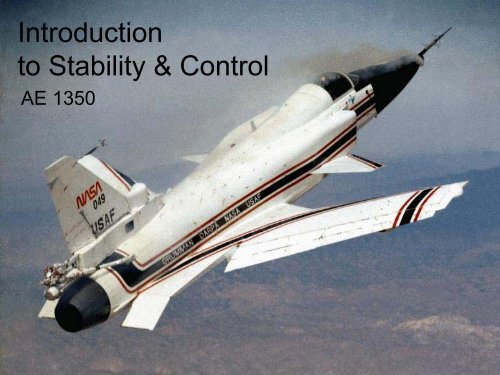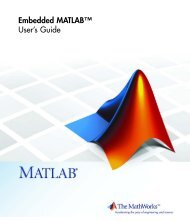Introduction to Stability & Control
Introduction to Stability & Control
Introduction to Stability & Control
Create successful ePaper yourself
Turn your PDF publications into a flip-book with our unique Google optimized e-Paper software.
<strong>Introduction</strong><br />
<strong>to</strong> <strong>Stability</strong> & <strong>Control</strong><br />
AE 1350
Outline<br />
• What do we mean by aircraft stability and control?<br />
• Static and Dynamic <strong>Stability</strong><br />
• Longitudinal, lateral and roll stability<br />
• Necessary Conditions for Longitudinal stability<br />
• <strong>Stability</strong> Margin<br />
• Relaxed <strong>Stability</strong> Margin
A system is stable if it can recover from<br />
A cone resting<br />
on its base is<br />
stable<br />
small disturbances<br />
Unstable Neutrally stable<br />
Assumes new position<br />
caused by the disturbance
Aircraft are subjected <strong>to</strong> disturbances:<br />
Freestream<br />
Unexpected Gust<br />
gusts/turbulence<br />
Will it recover au<strong>to</strong>matically, without pilot’s intervention,<br />
and resume its original direction of flight?<br />
If yes, then the aircraft is longitudinally stable
Alpha<br />
Aircraft is in<br />
steady level flight<br />
Longitudinal Static <strong>Stability</strong><br />
Time<br />
Alpha<br />
Gust pitches the nose up<br />
The initial tendency of the vehicle<br />
is <strong>to</strong> bring the nose down -<br />
The aircraft is statically stable<br />
The initial tendency of<br />
the vehicle is <strong>to</strong> bring<br />
the nose up -<br />
The aircraft is statically<br />
unstable<br />
Time
Alpha<br />
Aircraft may be statically and<br />
6<br />
5.5<br />
5<br />
4.5<br />
4<br />
3.5<br />
3<br />
dynamically stable<br />
0 10 20 30 40<br />
Gust pitches<br />
nose up<br />
Time<br />
Initial tendency and long-term tendency both are <strong>to</strong> recover<br />
from a gust or disturbance
Alpha,<br />
Degrees<br />
Aircraft may be statically stable, yet<br />
40<br />
20<br />
0<br />
-20<br />
dynamically unstable<br />
Longitudinal <strong>Stability</strong><br />
0 10 20 30 40<br />
Time, seconds
Condition for Static <strong>Stability</strong><br />
Aircraft c.g. (center of Gravity)<br />
L<br />
+ dL<br />
The gust generates a small clockwise Moment about c.g. dM, and a<br />
small positive additional lift dL<br />
For static stability, if dL is positive (upward gust),<br />
dM must be negative, causing the nose <strong>to</strong> drop<br />
Otherwise the wing will pitch up further increasing lift<br />
dM/dL must be negative for static stability
Nondimensionalization<br />
Lift and pitching moment M are usually non-dimensionalized.<br />
L is divided by [1/2 ρ V ∞ 2 S] <strong>to</strong> yield CL<br />
M is divided by [1/2 ρ V ∞ 2 S c] <strong>to</strong> yield CM<br />
Here, c is a reference length, e.g. “average” chord<br />
From previous slide, dM/dL must be negative for static stability<br />
In nondimensional form, dC M /dC L must be negative for<br />
static stability<br />
The quantity -dC M/dC L is called the static stability margin<br />
Notice the negative sign!<br />
The more positive it is, the more longitudinally stable the aircraft
How can a Designer Ensure<br />
Longitudinal Static stability?<br />
Aircraft c.g.<br />
Rule #1 : Place the c.g. as far forward as possible - This will<br />
cause the nose <strong>to</strong> drop, if lift increases due <strong>to</strong> a gust, reducing<br />
α, and lift / The opposite will occur if there is downward gust<br />
Lift
How can a Designer Ensure<br />
Longitudinal Static stability?<br />
Aircraft c.g.<br />
Tail Lift<br />
Rule #2 : Place the horizontal tail as far aft as possible - This will<br />
cause the nose <strong>to</strong> drop, if there is a vertical gust, reducing<br />
α, and lift / The opposite will occur if there is downward gust<br />
A canard is a tail upstream of the c.g., reduced static stability<br />
(move wing aft or c.g. forward <strong>to</strong> compensate)
The price paid for a large static<br />
stability margin<br />
• The aircraft may become sluggish, hard <strong>to</strong> maneuver;<br />
The tail will resist the pilot’s attempt <strong>to</strong> change the<br />
aircraft “angle of attack”<br />
• A large tail adds <strong>to</strong> aircraft weight, and cost<br />
• Tail generates drag!<br />
• A smaller tail will require a long fuselage (equivalent<br />
<strong>to</strong>rque by applying force farther away) <strong>to</strong> generate<br />
enough pitching moment <strong>to</strong> bring the nose up or<br />
down
Relaxed Static <strong>Stability</strong><br />
• For improved maneuverability, some aircraft sacrifice<br />
the static stability margin: relaxed static stability<br />
• Some fighter aircraft are statically unstable<br />
– Their nose will continue <strong>to</strong> pitch up, the lift will continue <strong>to</strong><br />
go up after an upward gust is encountered; Result: A/C will<br />
stall, “flip over”<br />
• These aircraft must be actively controlled by the pilot,<br />
or an onboard computer<br />
• Redundant computer systems are present in case a<br />
computer based flight control fails
Artificial <strong>Stability</strong> Augmentation<br />
zzz<br />
+<br />
<strong>Stability</strong><br />
Augmentation<br />
System
Air Transports, Boeing 747-400<br />
Can Reduce <strong>Stability</strong> (and therefore drag)<br />
in Cruise by Pumping Fuel <strong>to</strong> Tail
Eleva<strong>to</strong>rs<br />
Stabilizer Trim<br />
Eleva<strong>to</strong>rs/Stab Trim: B747
<strong>Stability</strong> and <strong>Control</strong> Augmentation<br />
zzz<br />
<strong>Stability</strong> & <strong>Control</strong><br />
Augmentation<br />
System (SCAS)
Super-augmented Aircraft<br />
X-29<br />
F-16
Saab Gripen (JAS-39B)<br />
Digital Fly-by-wire:<br />
Reduced Drag at High-G
When the Actua<strong>to</strong>rs Saturate…
Freestream comes from pilot’s<br />
right side, due <strong>to</strong> cross wind<br />
It causes nose <strong>to</strong> rotate <strong>to</strong> left<br />
viewed from the <strong>to</strong>p<br />
Directional <strong>Stability</strong><br />
A cross wind may cause the nose <strong>to</strong> rotate about the vertical axis,<br />
changing the flight direction<br />
The vertical tail behaves like a wing at an angle of attack,<br />
producing a side force, rotates the aircraft <strong>to</strong> its original direction<br />
All of this occurs without pilot action or intervention<br />
The force on the tail<br />
causes the aircraft<br />
<strong>to</strong> rotate back <strong>to</strong><br />
original direction
Enough Vertical Fin for Lightly Damped<br />
Directional Oscillations “Dutch Roll”
Rudders<br />
Rudders: B747
Lateral <strong>Stability</strong><br />
• It is the ability of the aircraft <strong>to</strong> recover from a roll<br />
disturbance without pilot<br />
intervention<br />
Dihedral is good for<br />
lateral stability<br />
If the wing is tilted upwards<br />
from root <strong>to</strong> tip, it has a<br />
dihedral
What happens when the aircraft<br />
undergo a roll?<br />
Lift<br />
A portion of the lift is pointed sideways<br />
The vehicle moves laterally -<br />
This is called sideslip<br />
Lift
During sideslip, a relative wind flows<br />
from right <strong>to</strong> left: Lateral Static <strong>Stability</strong><br />
A similar downwash occurs<br />
on the left wing,<br />
reducing lift<br />
Lift<br />
As a result, the aircraft rights itself,<br />
and recovers from the roll!<br />
This wind has<br />
a component normal<br />
<strong>to</strong> the wing on<br />
the right, viewing<br />
from the front<br />
This is an upwash.<br />
The upwash increases<br />
lift on the right wing
Anhedral is bad for<br />
lateral stability<br />
Anhedral<br />
If the wing dips down from root<br />
<strong>to</strong> tip, it has an anhedral
Dihedral Effect<br />
• Dihedral effect can come from<br />
– From wing dihedral, high wing, or wing sweep<br />
– From vertical tail<br />
• Anhedral can be used <strong>to</strong> get desired level of dihedral<br />
effect<br />
AV-8B<br />
F-104
High/Low Speed Ailerons: B747<br />
Low Speed Aileron<br />
Roll Spoilers<br />
High Speed Aileron
The Wrights<br />
• Conventional Wisdom: Airplane should hold course,<br />
and the pilot should deflect the rudder <strong>to</strong> turn, the<br />
“Boat Model”<br />
• Wrights invented wing warping, first lateral control<br />
• Early Wright airplanes where unstable, difficult <strong>to</strong> fly,<br />
and maneuverable
…and then it gets complicated




